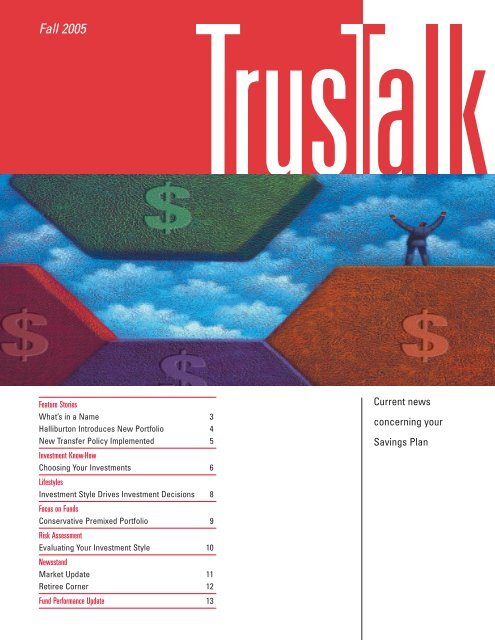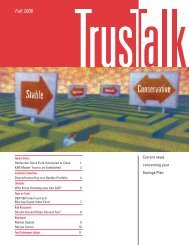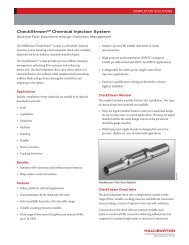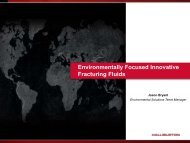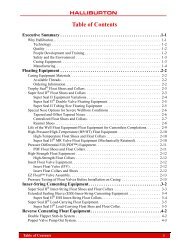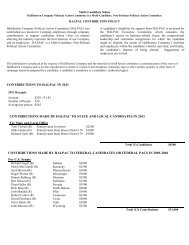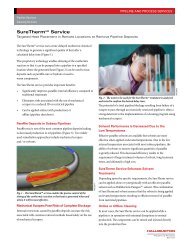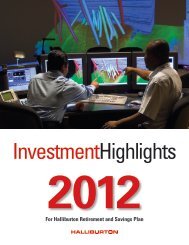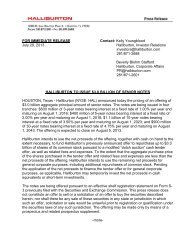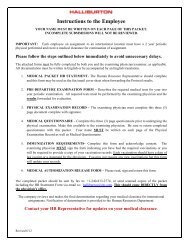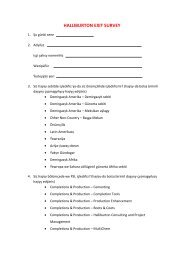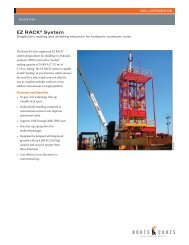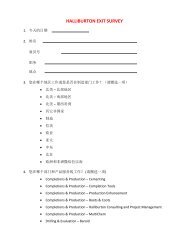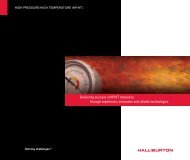Fall 2005 - Halliburton
Fall 2005 - Halliburton
Fall 2005 - Halliburton
You also want an ePaper? Increase the reach of your titles
YUMPU automatically turns print PDFs into web optimized ePapers that Google loves.
<strong>Fall</strong> <strong>2005</strong><br />
Summer 2004<br />
Feature Stories<br />
What’s in a Name 3<br />
<strong>Halliburton</strong> Introduces New Portfolio 4<br />
New Transfer Policy Implemented 5<br />
Investment Know-How<br />
Choosing Your Investments 6<br />
Lifestyles<br />
Investment Style Drives Investment Decisions 8<br />
Focus on Funds<br />
Conservative Premixed Portfolio 9<br />
Risk Assessment<br />
Evaluating Your Investment Style 10<br />
Newsstand<br />
Market Update 11<br />
Retiree Corner 12<br />
Fund Performance Update 13<br />
Current news<br />
concerning your<br />
Savings Plan
The <strong>Halliburton</strong> Trust Investments Department<br />
Seated, left to right: Sharon Parkes, Wendy Wang.<br />
Back row, left to right: Nat Duffield, Brinda Maxwell, Maria Bacaling.<br />
Trust Talk is published quarterly by the <strong>Halliburton</strong> Trust Investments Department. It is designed to provide Savings Plan<br />
members with conventional wisdom on saving and investing. The information included in Trust Talk is not intended as<br />
investment advice. You may want to consult a financial advisor before making any investment decisions.<br />
2<br />
Suggestions or comments about Trust Talk can be sent to: Nat Duffield or Sharon Parkes, Trust Investments Department,<br />
10200 Bellaire Blvd., Houston, TX 77072.
Feature<br />
What’s in a Name?<br />
<strong>Halliburton</strong> consistently has offered employees a variety of<br />
investment fund opportunities within the Savings Plan. Among<br />
those funds are three that are different from the others: the<br />
Fixed Income Fund (FIF), the General Investment Fund (GIF)<br />
and the Equity Investment Fund (EIF). Since their inception, these funds<br />
were designed to provide investors with a one-stop-shopping<br />
approach to investing. Combined, they employ more than twenty<br />
managers with differing investment styles and stock capitalizations.<br />
Often called lifestyle funds, they are risk-based asset<br />
allocation funds designed to provide diversification<br />
when used as a sole investment. Although lifestyle<br />
funds recently have gained popularity, <strong>Halliburton</strong> has<br />
offered these funds for years.<br />
On January 1, 2006, we will re-introduce our original<br />
lifestyle funds and rename them to more accurately<br />
capture their core objective: providing premixed asset<br />
allocation portfolios with varying risk levels. The<br />
management, investment and corresponding asset<br />
allocation objectives of these portfolios remain<br />
unchanged.<br />
Changes Coming in 2006<br />
The Benefits and Investment Committees have<br />
developed several changes to the Savings Plan, which<br />
will take effect January 1, 2006. First, they will be<br />
introducing a new investment opportunity with the<br />
Conservative Premixed Portfolio. In addition, the names<br />
of several of our existing funds are going to change to<br />
align more closely with their original purpose. They also<br />
will be implementing a new trading policy governing<br />
fund transfers and reallocations.<br />
This issue of Trust Talk is devoted to informing you of all the<br />
upcoming changes.<br />
➤➤➤➤<br />
JANUARY 1, 2006<br />
Old Name ➤ New Name Same Purpose<br />
Fixed Income Fund<br />
(FIF)<br />
General Investment<br />
Fund (GIF)<br />
Equity Investment<br />
Fund (EIF)<br />
➤<br />
➤<br />
➤<br />
Stable Value<br />
Premixed Portfolio<br />
Moderate Premixed<br />
Portfolio<br />
Aggressive Premixed<br />
Portfolio<br />
To provide preservation of principal and a relatively stable rate<br />
of return, with little risk or volatility, by investing primarily in<br />
bank and insurance investment contracts.<br />
To provide long-term growth while minimizing risks by<br />
diversifying investments among different types of assets.<br />
To provide long-term growth, with a relatively higher level of<br />
risk, by investing primarily in stocks and related securities.<br />
3
Feature<br />
<strong>Halliburton</strong> Introduces New Portfolio<br />
In addition to our existing portfolio options, on January 1, 2006,<br />
<strong>Halliburton</strong> will introduce a fourth portfolio targeted to investors<br />
who are approaching or in retirement, or are more conservative in<br />
their investing due to their risk tolerance. The Conservative<br />
Premixed Portfolio’s asset allocation provides it with opportunity for<br />
growth while still providing some security against market fluctuations.<br />
The Conservative Premixed<br />
Portfolio includes three asset<br />
class allocations: global stocks<br />
(38%), bonds (24%) and stable<br />
value (38%). The balance<br />
between the stocks and stable<br />
value investments is designed to<br />
offer growth potential while<br />
mitigating the volatility normally<br />
associated with the stock market.<br />
The managers of the Stable<br />
Value, Moderate and Aggressive<br />
Premixed Portfolios will also<br />
manage the new portfolio’s<br />
holdings. In addition, the country<br />
allocation and top sector holdings<br />
for the global stock portion of the<br />
new portfolio closely match those<br />
of the Moderate and Aggressive Premixed Portfolios.<br />
The bonds are the same as those held in the Moderate<br />
Premixed Portfolio. The stable value investments will<br />
closely resemble and have some of the same holdings<br />
as the Stable Value Premixed Portfolio.<br />
38%<br />
38%<br />
Global Stocks<br />
Bonds<br />
Stable Value 24%<br />
4
Feature<br />
New Transfer Policy Implemented<br />
It’s a mantra repeated by many financial advisors, “Retirement<br />
savings are for retirement.” It helps investors get in the mindset that<br />
they are saving for the long term. In fact, most of the participants in<br />
<strong>Halliburton</strong>’s funds act in a manner that is consistent with this<br />
objective. However, a small number of plan participants engaging in<br />
rapid-fire trades within a short period of time could affect fund<br />
performance and negatively impact the majority of the plan<br />
participants. This occurrence is not unique to <strong>Halliburton</strong>. According to<br />
the Committee on Investment of Employee Benefit Assets (CIEBA),<br />
about 70 percent of large plan sponsors have taken action to control<br />
market timing in their plans. An additional 14 percent intend to address<br />
the issue in the near future.<br />
In our own efforts to address the potential adverse<br />
effects of market timing, effective January 1, 2006,<br />
<strong>Halliburton</strong> will implement a new Investment Transfer<br />
Policy, which places waiting periods on transfers and<br />
reallocations into and out of all funds. These limits do<br />
not apply to rollovers, new contributions, loans or<br />
withdrawals. In addition, the new policy replaces the<br />
current transfer policy governing the Non-U.S. Fund.<br />
For all of the funds and portfolios, except the Stable<br />
Value Premixed Portfolio, if you make a transfer or a<br />
fund reallocation out of a fund, you<br />
cannot transfer money into that<br />
same fund for 20 calendar days.<br />
For example, if on January 1 you<br />
make a transfer or a fund<br />
reallocation out of the Mid Cap<br />
Equity Fund you will have to wait<br />
until January 21 to make any<br />
transfers or reallocations into that<br />
fund. Each time a transfer or fund<br />
reallocation is made out of a fund,<br />
the waiting period resets to the<br />
date of the latest transaction.<br />
Therefore, if you decide on January 10 that you want to<br />
transfer additional money out of the Mid Cap Equity<br />
Fund, you will now have to wait until January 31 to<br />
make any transactions back into that fund.<br />
The policy governing the Stable Value Premixed<br />
Portfolio works differently. If money is transferred or<br />
funds reallocated into the Stable Value Premixed<br />
Portfolio, the number of units that money represented<br />
on the day of the transaction are restricted and cannot<br />
be transferred out of the portfolio for 20 calendar days.<br />
For example, if on January 1 you<br />
transfer $150 into the Stable Value<br />
Premixed Portfolio and each $15<br />
equals one unit, then you have<br />
added 10 units to your portfolio and<br />
those 10 units cannot be<br />
transferred out for 20 calendar<br />
days. However, any balance in this<br />
portfolio prior to the transaction is<br />
not subject to the waiting period.<br />
5
Investment Know-How<br />
Choosing Your Investments<br />
Choosing the right investment vehicles is one of the most<br />
important investment decisions you can make. Lifestyle funds<br />
seek to make balancing your portfolio easier for you by investing<br />
in the various asset classes at weights within predetermined<br />
ranges to meet the fund’s investment strategies and goals.<br />
<strong>Halliburton</strong>’s Premixed Portfolios are lifestyle funds that<br />
base their asset allocation on targeted risk and return<br />
profiles, such as aggressive, moderate, conservative<br />
and stable value. The <strong>Halliburton</strong> Investment<br />
Committee creates a portfolio diversified across<br />
several asset classes, such as stocks, bonds and<br />
stable value funds designed to meet specific objectives<br />
as set out in an investment policy statement and<br />
implemented by the Trust Department. Participants can<br />
pick the portfolio that most closely matches their risk<br />
tolerance, investment style and/or return requirements<br />
for their investment goals and situation. Over time,<br />
participants can move from one fund to another as<br />
their circumstances or needs change.<br />
• Lack of Diversification – A recent Vanguard study<br />
showed that almost 50 percent of plan participants<br />
use only one or two investment options. Since only a<br />
small portion of retirement assets are in diversified<br />
lifestyle funds, most participant’s portfolios are likely<br />
under diversified. Each of <strong>Halliburton</strong>’s Premixed<br />
Portfolios invests in a variety of asset classes to<br />
provide the appropriate level of diversification for its<br />
targeted risk level and return goals. The portfolios<br />
offer the simplicity of a single investment while<br />
providing multiple asset class diversification.<br />
The Premixed Portfolios also help avoid<br />
many of the common mistakes participants<br />
make in their retirement portfolio. These<br />
mistakes include:<br />
• Risk Management – One of the most<br />
common investing errors is not taking<br />
enough risk. Participants who make this<br />
mistake may find themselves without<br />
adequate returns to meet their retirement<br />
goals. The Premixed Portfolios are<br />
designed to provide consistent risk<br />
exposure and provide the maximum return<br />
for the specified level of risk.<br />
Premixed Portfolios<br />
Stable Value Premixed Portfolio<br />
(formerly FIF)<br />
Conservative Premixed Portfolio<br />
(new offering)<br />
Moderate Premixed Portfolio<br />
(formerly GIF)<br />
Aggressive Premixed Portfolio<br />
(formerly EIF)<br />
Single Focus Funds<br />
Bond Index Fund<br />
Balanced Fund<br />
Large Cap Value Equity Fund<br />
S&P 500 Index Fund<br />
Large Cap Growth Equity Fund<br />
Non-U.S. Equity Fund<br />
Mid Cap Equity Index Fund<br />
Small Cap Equity Fund<br />
<strong>Halliburton</strong> Stock Fund<br />
6
Investment Know-How<br />
• Portfolio Rebalance – Hewitt Associates’ recent<br />
survey of 500,000 savings plan participants found<br />
that only one in five participants adjust their<br />
investment portfolios. When portfolios are not<br />
rebalanced to reflect market changes, participants<br />
can end up with a very different level of risk than<br />
they were expecting when they first invested. For<br />
example, if you were to create a portfolio with a mix<br />
of assets including stocks and bonds, the stocks, at<br />
least in this current market, would likely grow more<br />
quickly than the bonds. This would create an<br />
allocation imbalance as a higher percentage of your<br />
portfolio would be in stocks. With more of your<br />
allocation in stocks, you would be exposed to a<br />
higher risk level than you initially anticipated. You<br />
would then need to reallocate your investments to<br />
bring your risk level back in line with your original<br />
goals. The Premixed Portfolios do this rebalancing<br />
for you. The Investment Committee actively monitors<br />
the investments to make sure the portfolios stay<br />
within the level of risk assigned to them.<br />
run the risk of over diversifying. Participants investing<br />
in both Premixed Portfolios and Single Focus Funds<br />
may want to consult a financial advisor who can help<br />
them understand their diversification and risk exposure<br />
for their choices.<br />
Since the Premixed Portfolios are professionally<br />
managed, self-balancing and well diversified, any one<br />
of them can be used as a complete investment<br />
strategy.<br />
<strong>Halliburton</strong>’s Savings Plan Options<br />
Participants who are looking for a diverse portfolio<br />
without having to create and maintain it themselves,<br />
can choose from the plan’s four Premixed Portfolios.<br />
The portfolios are actively managed and rebalanced to<br />
ensure they maintain the level of diversification and<br />
risk exposure as set out in their objectives.<br />
Participants who want to create their own portfolios<br />
can choose from the plan’s other nine funds, which<br />
cover a range of asset classes and are now being<br />
branded as Single Focus Funds. Our Single Focus<br />
Funds include actively managed and indexed funds.<br />
Financial advisors typically warn against investing in<br />
both premixed portfolios and individual funds since you<br />
7
Lifestyles<br />
Investment Style Drives Investment Decisions<br />
Martin and Barbara are at different stages of their lives. They<br />
invest their money in different vehicles based on their<br />
individual needs. In addition, they also have different<br />
investing styles, which play a large role in how they make<br />
their investment decisions.<br />
Martin<br />
Martin is in his early forties, is<br />
married and has two schoolaged<br />
children. His wife works<br />
and has invested in her company’s retirement plan. They<br />
are active investors and enjoy researching the various<br />
options available to them. Martin frequently reads the<br />
market reports and considers himself an experienced<br />
investor. He has a number of investments in a personal<br />
portfolio.<br />
Because of his experience, knowledge and desire to be<br />
involved with his investments, Martin chooses to<br />
allocate his plan contributions in several of the Single<br />
Focus Funds. He reviews his investments quarterly to<br />
ensure that they are meeting his investment and<br />
diversification needs. If he finds that they are out of<br />
balance, he either reallocates his contributions or<br />
moves his balances into other funds, as needed.<br />
Martin has chosen an investment style that works best<br />
for him. His investment knowledge is high and he wants<br />
to be involved in the decision making for his investments.<br />
The Single Focus Funds provide him with a variety of<br />
choices to create a portfolio that is right for him.<br />
Barbara<br />
Barbara is within five years of<br />
retirement and currently invests<br />
most of her money in the S&P<br />
500 Index Fund with some of her contributions going to<br />
the Bond Index Fund. She has determined that her risk<br />
tolerance indicates a more conservative approach than<br />
she has in her current allocations. However, she doesn’t<br />
have the time (or the inclination) required to monitor her<br />
investments to make sure that they are producing the<br />
long-term results she wants at an appropriate risk<br />
exposure for her comfort level.<br />
Since Barbara is near retirement, she is looking for<br />
investments in more secure asset classes, while still<br />
providing growth opportunity. She also realizes that her<br />
investment style leads her to look at the Premixed<br />
Portfolios. Understanding that the portfolios are created<br />
to be sole investment devices, Barbara has decided that<br />
she is going to move the balances of her Single Focus<br />
Funds and change her future allocations to invest in the<br />
Conservative Premixed Portfolio.<br />
8
Focus on Funds<br />
Conservative Premixed Portfolio<br />
In this issue of Trust Talk, we will examine the Conservative Premixed Portfolio, available January 1, 2006. The<br />
Conservative Premixed Portfolio invests in global stocks, bonds and stable value investments. This portfolio is<br />
positioned toward the lower end of the risk/return spectrum.<br />
Conservative Premixed<br />
Aggressive Premixed<br />
Premixed Portfolios<br />
Single Focus Funds<br />
Lower<br />
Risk/<br />
Lower<br />
Return<br />
Stable Value Premixed<br />
Bond Index<br />
Moderate Premixed<br />
Balanced<br />
Large Cap Growth Equity Small Cap Equity<br />
S&P 500 Index<br />
Mid Cap Equity<br />
Higher<br />
Risk/<br />
Higher<br />
Return<br />
Large Cap Value Equity<br />
Non-U.S. Equity<br />
<strong>Halliburton</strong> Stock<br />
In future issues of Trust Talk, we will return to comparing other funds along the risk/return<br />
spectrum. For information on previously reviewed funds, refer to earlier issues of Trust Talk.<br />
Conservative Premixed Portfolio<br />
Objective and Investment Strategy<br />
To achieve long-term growth with a relatively low level of risk. Stocks provide growth for the portfolio<br />
balanced by bonds and asset-backed investment contracts which minimize risk and short-term<br />
volatility.<br />
Estimated Annual 2006 Expense Ratio<br />
0.48%<br />
Fund Composition<br />
Long-Term Potential Risk & Return<br />
Market Risk ▲ ▲ ▲<br />
38%<br />
24%<br />
38%<br />
Global Stocks<br />
Bonds<br />
Stable Value<br />
Inflation Risk ▲ ▲ ▲<br />
Potential Return ▲ ▲<br />
Low Med High<br />
9
Risk Assessment<br />
Evaluating Your Investment Style<br />
How involved you want to be in making your investment<br />
decisions can play a key role in where you invest your money.<br />
By evaluating your own investment style preferences, you can<br />
determine whether you would be more comfortable choosing<br />
from the Premixed Portfolios or the Single Focus Funds.<br />
Answer the following questions and add up the points associated with each question.<br />
How much time per quarter do you<br />
want to spend evaluating the plan’s<br />
investment options?<br />
On average, how often do you check<br />
performance results for your<br />
investments?<br />
How would you rate your level of<br />
experience as an investor?<br />
How confident are you that your<br />
investment decisions will be right for<br />
your circumstances and goals?<br />
On average, how often do you watch<br />
financial programs on T.V. or read<br />
financial publications?<br />
How often do you monitor and<br />
rebalance your investments?<br />
How well do you understand<br />
investment risk?<br />
How well do you understand inflation<br />
risk?<br />
Which would best describe your<br />
approach to investing?<br />
1. As little time as<br />
possible<br />
2. One to three hours 3. As much time as needed<br />
1. Annually 2. Quarterly 3. Weekly<br />
1. Low 2. Moderate 3. High<br />
1. Not confident 2. Somewhat confident 3. Very confident<br />
1. Never 2. Once in awhile 3. Most of the time<br />
1. Never 2. Annually 3. Quarterly<br />
1. Not well 2. Somewhat 3. Very well<br />
1. Not well 2. Somewhat 3. Very well<br />
1. I want to delegate<br />
investment decisions to<br />
financial professionals<br />
2. I want to delegate<br />
investment decisions to<br />
financial professionals, but<br />
monitor how they are doing<br />
3. I want to make my own<br />
investment decisions and<br />
make adjustments to them<br />
when necessary<br />
Score:<br />
9 – 14: You will probably be most comfortable with one of the Premixed Portfolios that matches your risk tolerance<br />
level. Participants in these investments take advantage of the actively managed accounts that are self-balancing to<br />
ensure they continue to maintain their risk/return objectives.<br />
15 – 21: You may be comfortable with either investment style: choosing from one of the Premixed Portfolios or<br />
creating your own portfolio from among the Single Focus Funds.<br />
22 – 27: You will probably like to select your investments from the Single Focus Funds. These funds may require more<br />
time and involvement on your part to create, monitor and adjust your portfolio over time to meet your investment and<br />
risk tolerance needs.<br />
10
Newsstand<br />
Market Update<br />
The third quarter of <strong>2005</strong> proved to be relatively calm for<br />
most of the investment marketplace, despite devastating<br />
storms in the Gulf of Mexico. In seeming defiance of<br />
hurricanes Katrina and Rita, the equity markets<br />
continued to grow steadily during the quarter. Stocks in<br />
both the U.S. and abroad produced positive results in the<br />
third quarter and saw the highest level in four years for<br />
the S&P 500 Index. Although rising oil and gas prices<br />
began to make their way into the economic statistics,<br />
they didn’t appear to negatively impact market<br />
performance. At one point, oil prices rose above $70 per<br />
barrel but fell to $66 per barrel by the quarter’s end. The<br />
U.S. bond market saw slight declines as the Federal<br />
Reserve increased short-term interest rates by 0.5%.<br />
In the U.S., stock market results started strong early in<br />
the quarter, turned down in August and were relatively<br />
flat in September. Still, the S&P 500 Index of large cap<br />
stocks gained 3.6% for the quarter and 2.8% for the year<br />
to date. U.S. small cap stocks gained 4.7% in the third<br />
quarter and 3.4% so far this year. Expectations for the<br />
S&P 500 were for growth of more than 15% in the third<br />
quarter versus the prior year, however, concerns over<br />
inflation and rising interest rates kept stock prices in<br />
check. Growth stocks outperformed value stocks for the<br />
quarter, but value stocks remain on top year to date.<br />
Investors in non-U.S. stocks enjoyed another quarter of<br />
strong performance with the MSCI ACWI Index gaining<br />
11.8%. The U.S. dollar remained relatively stable and<br />
did not negatively impact returns as in previous<br />
quarters. Japan and the Pacific region equities<br />
produced returns of around 20% for the quarter while<br />
Europe and the UK stock markets produced returns<br />
below 10%. The Emerging Markets produced another<br />
huge gain for U.S. investors, gaining 18.1% in the third<br />
quarter and 25.5% year to date.<br />
For the bond markets, the continuing rise in shortterm<br />
interest rates drove returns slightly down for<br />
the quarter. The Lehman Brothers Aggregate Index<br />
returned -0.7% for the quarter but was up 1.8% for<br />
the year to date. The U.S. yield curve continued to<br />
flatten during the quarter, as short term interest rates<br />
rose and longer term rates remained stable. For the<br />
third quarter, the high yield segment (below<br />
investment grade) was the top performer of the<br />
major market segments, followed by mortgagebacked<br />
securities, Treasury securities, and corporate<br />
bonds. For the year to date, all of the major segments<br />
of the bond market produced returns of between<br />
1% and 2%.<br />
Five-Year Performance of Major Asset Classes<br />
Cumulative Percentage Increase/Decrease – Monthly Observations<br />
120%<br />
100%<br />
80%<br />
60%<br />
40%<br />
20%<br />
0%<br />
-20%<br />
-40%<br />
-60%<br />
OCT 00<br />
JAN 01<br />
APR 01<br />
JUL 01<br />
OCT 01<br />
JAN02<br />
APR 02<br />
JUL 02<br />
OCT 02<br />
JAN 03<br />
APR 03<br />
JUL 03<br />
OCT 03<br />
JAN 04<br />
APR 04<br />
JUL 04<br />
OCT 04<br />
JAN 05<br />
APR 05<br />
JUL 05<br />
U.S. Large Stocks U.S. Small Stocks U.S. Bonds Non-U.S. Stocks Emerging Market Stocks<br />
11
Newsstand<br />
Retiree Corner<br />
What the Portfolios Mean to You<br />
Participants in the Fixed Income Fund, General<br />
Investment Fund or the Equity Investment Fund, will<br />
only see a change to the fund names (see What’s in a<br />
Name?). They will maintain their same investment<br />
managers, strategies and objectives<br />
under the new names. The other<br />
funds maintain their original names,<br />
but will now be branded as Single<br />
Focus Funds. You don’t need to do<br />
anything if you are still satisfied with<br />
your investment decisions.<br />
However, you do have a new<br />
portfolio option to consider. The<br />
Conservative Premixed Portfolio is<br />
designed for individuals<br />
approaching or in retirement. The<br />
portfolio offers the opportunity for growth still needed<br />
during the early years of retirement, while providing<br />
balance against market volatility with investments in<br />
stable value classes.<br />
For those individuals who don’t want to spend the<br />
time selecting individual funds or who want to select<br />
a targeted risk level for investing, the Premixed<br />
Portfolios may be a good choice. The portfolios are<br />
highly diversified, self-balancing investment<br />
vehicles. Investors in the portfolios are encouraged<br />
to select the one that best fits<br />
their investment goals and risk<br />
level. Investing in more than one<br />
portfolio or investing in one of the<br />
portfolios as well as Single Focus<br />
Funds may produce exposure to<br />
risk and returns that are<br />
unexpected. Many financial<br />
advisors suggest using the<br />
premixed portfolios as a sole<br />
investment vehicle.<br />
Whether you have invested in<br />
one of the Premixed Portfolios or in the Single Focus<br />
Funds, you should periodically review your<br />
investments to make sure that they continue to fit<br />
your circumstances and your needs.<br />
Fast Facts<br />
2006 IRS Contribution Limits<br />
The IRS sets maximum amounts for<br />
contributions to your retirement and<br />
savings accounts. Contributions to<br />
<strong>Halliburton</strong>'s investment funds fall under<br />
the limits set for regular 401(k)<br />
contributions. Participants over 50 years<br />
old, may be able to make an additional<br />
catch-up contribution. If you made a<br />
catch-up election in <strong>2005</strong>, it will carry over<br />
to 2006 unless you make a new election.<br />
Here are the 2006 IRS maximum<br />
contribution amounts for all types of<br />
retirement investments.<br />
Account<br />
Traditional and<br />
Roth IRA<br />
SIMPLE IRA and<br />
SIMPLE 401(k)<br />
Regular 401(k),<br />
403(b) and<br />
SARSEPs<br />
Annual<br />
Contribution<br />
Limit<br />
Annual<br />
Catch-up<br />
Limit<br />
$4,000 $1,000<br />
$10,000 $2,500<br />
$15,000 $5,000<br />
12
Fund Performance Update<br />
<strong>Halliburton</strong> Company Employee Benefit Master Trust<br />
for the period ended September 30, <strong>2005</strong><br />
General investment policy<br />
Balanced Fund Aggressive Moderate Conservative<br />
U.S. stocks 65.0% 70.0% 43.0% 27.0%<br />
Russell 3000 Index<br />
Non-U.S. stocks — 22.5% 14.0% 8.0%<br />
MSCI EAFE Index<br />
Emerging market stocks — 7.5% 5.0% 3.0%<br />
MSCI Emerging Market Free Index<br />
U.S. broad market bonds 35.0% — 33.0% 21.0%<br />
Lehman Aggregate Bond Index<br />
U.S. high yield bonds — — 5.0% 3.0%<br />
Merrill Lynch High Yield Bond Index<br />
iMoneyNet Money Market Fund Average — — — 38.0%<br />
Performance<br />
10 Years* 5 Years* 3 Years* 1 Year 3rd Quarter<br />
PREMIXED PORTFOLIOS<br />
Stable Value Premixed Portfolio (FIF) 6.3% 5.5% 4.9% 5.0% 1.3%<br />
iMoneyNet Money Market Fund Average 3.5% 1.9% 1.2% 2.1% 0.7%<br />
Conservative Premixed Portfolio 7.6% 5.1% 11.5% 10.7% 3.2%<br />
Composite 6.3% 3.0% 9.8% 8.9% 2.6%<br />
Moderate Premixed Portfolio (GIF) 8.7% 5.0% 16.1% 14.9% 4.5%<br />
Composite 8.1% 3.7% 15.1% 13.1% 3.8%<br />
Aggressive Premixed Portfolio (EIF) 9.2% 2.7% 20.4% 21.1% 7.3%<br />
Composite 8.6% 1.3% 21.2% 19.3% 6.5%<br />
SINGLE FOCUS FUNDS<br />
Bond Index Fund 6.4% 6.5% 3.9% 2.7% -0.7%<br />
Lehman Aggregate Bond Index 6.6% 6.6% 4.0% 2.8% -0.7%<br />
Balanced Fund 10.4% 8.0% 14.6% 12.5% 4.3%<br />
Composite 8.8% 2.2% 13.2% 10.4% 2.4%<br />
Large Cap Value Equity Fund 11.5% 7.3% 19.4% 19.4% 4.3%<br />
Russell 1000 Value Index 11.5% 5.8% 20.5% 16.7% 3.9%<br />
S&P 500 Index Fund 9.4% -1.6% 16.6% 12.2% 3.6%<br />
S&P 500 Index 9.5% -1.5% 16.7% 12.3% 3.6%<br />
Large Cap Growth Equity Fund 7.5% -6.1% 13.6% 13.7% 5.3%<br />
Russell 1000 Growth Index 6.9% -8.6% 14.7% 11.6% 4.0%<br />
Non-U.S. Equity Fund 7.9% 4.6% 25.1% 29.0% 12.8%<br />
MSCI ACWI ex U.S. ** 6.1% 3.7% 25.6% 28.9% 11.8%<br />
Mid Cap Equity Index Fund 14.0% 7.0% 21.9% 22.1% 4.8%<br />
S&P MidCap 400 Index 14.1% 7.1% 22.1% 22.2% 4.9%<br />
Small Cap Equity Fund 10.0% 5.2% 20.1% 16.9% 5.0%<br />
Russell 2000 Index 9.4% 6.5% 24.1% 18.0% 4.7%<br />
<strong>Halliburton</strong> Stock Fund 14.4% 8.4% 75.0% 101.9% 42.4%<br />
* Annualized<br />
** Returns prior to January 1, <strong>2005</strong> include MSCI EAFE Index, the previous Fund benchmark.<br />
13
Performance Notes<br />
The Bond Index, Balanced, Large Cap Value Equity,<br />
S&P 500 Index, Large Cap Growth Equity, Non-U.S.<br />
Equity, and Small Cap Equity Funds were not in<br />
existence until April 1, 1999. The Mid Cap Equity Index<br />
Fund was not in existence until January 1, <strong>2005</strong>. The<br />
Conservative Premixed Portfolio will be introduced in<br />
January 2006 and the performance data presented in<br />
this newsletter is proforma.<br />
In order to provide comparative historical returns, the<br />
managers’ return of their <strong>Halliburton</strong> Trust account is<br />
shown. If the <strong>Halliburton</strong> Trust had not employed a<br />
manager for the periods presented, the firm’s<br />
composite account return was added. All rates of<br />
return are net of expenses. Your rate of return may vary<br />
depending on your account activity (e.g., contributions,<br />
withdrawals, transfers, loans, etc.) and your plan’s<br />
administration expenses.<br />
To help you better understand how your funds are<br />
performing, the funds are compared with composite<br />
returns or with appropriate indexes. The composites<br />
are created by blending together index returns in<br />
proportion to the investment policy of each fund (see<br />
chart). Because there are no indices comparable to the<br />
Stable Value Premixed Portfolio’s investments, we<br />
compare its return with money market funds tracked by<br />
iMoneyNet.<br />
The performance data represent past performance,<br />
and no assurance can be made regarding future<br />
results.<br />
Index Definitions*<br />
iMoneyNet Money Market Fund Average is an index of<br />
over 700 money market funds.<br />
Lehman Aggregate Bond Index is an index of U.S.<br />
bonds, including government, corporate, mortgagebacked,<br />
and asset-backed securities.<br />
Merrill Lynch High Yield Bond Index is an index of U.S.<br />
corporate bonds that are rated less than investment<br />
grade but are not in default.<br />
MSCI (Morgan Stanley Capital International) All<br />
Country World Index (ACWI) ex. U.S. is an index of<br />
non-U.S. stocks listed on the exchanges of developed<br />
and emerging markets.<br />
MSCI EAFE Index is an index of non-U.S. stocks listed<br />
on the exchanges of Europe, Australasia, and the Far<br />
East.<br />
MSCI Emerging Market Free Index is an index of non-<br />
U.S. stocks traded in emerging markets.<br />
Russell 1000 Growth Index focuses on the 1,000 largest<br />
companies in the Russell 3000 Index that have lower<br />
dividend yields and above-average growth rates.<br />
Russell 1000 Value Index focuses on the 1,000 largest<br />
companies in the Russell 3000 Index that have higher<br />
dividend yields and below-average growth rates.<br />
Russell 2000 Index measures the performance of the<br />
2,000 smallest companies in the Russell 3000 Index.<br />
Russell 3000 Index measures the performance of the<br />
3,000 largest U.S. companies based on total market<br />
capitalization. It is used as a general measure of U.S.<br />
stock market performance.<br />
Standard & Poor’s 500 Index is a popular standard for<br />
measuring large-cap U.S. stock market performance.<br />
The index includes a representative sample of 500<br />
leading companies in prominent industries.<br />
Standard & Poor’s MidCap 400 Index is a popular<br />
standard for measuring mid-cap U.S. stock market<br />
performance. The index includes a representative<br />
sample of 400 leading companies in prominent<br />
industries with a market capitalization of approximately<br />
$1 – $4 billion.<br />
*You cannot invest in any of these indexes. Fund holdings will differ<br />
from index holdings.<br />
14
10200 Bellaire Blvd.<br />
Houston, TX 77072<br />
We encourage you to contact<br />
the Trust Investments<br />
Department with any<br />
suggestions or comments<br />
regarding Trust Talk. You can<br />
expect the next issue in<br />
February 2006.<br />
12465 11/05


